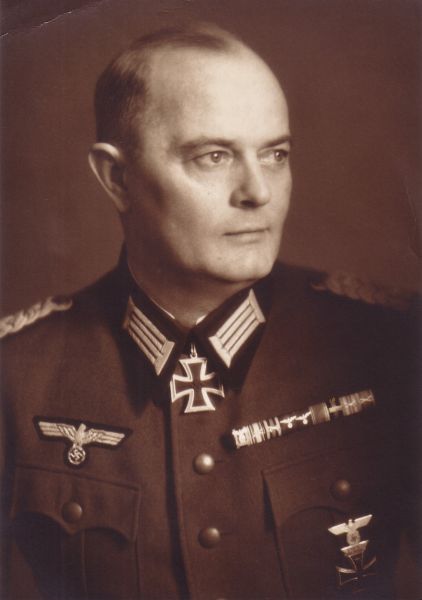Glasl, Anton
- Date of birth:
- February 13th, 1897 (Freising/Bavaria, Germany)
- Date of death:
- April 17th, 1965 (Mühldorf am Inn/Bavaria, Germany)
- Nationality:
- German (1933-1945, Third Reich)
Biography
Anton Glasl served as Ia 10. Gebirgs-Division, Ia VIII. Armeekorps and with Gebirgsjäger-Regiment 100. He finally reached the rank of Generalmajor. He was a POW from May 9th, 1945 until June 30th, 1947.
Promotions:
October 1st, 1916: Fahnenjunker-Unteroffizier;
May 31st, 1917: Fähnrich;
September 10th, 1917: Leutnant;
July 31st, 1925: Oberleutnant;
April 1st, 1933: Hauptmann;
August 1st, 1936: Major;
April 1st, 1939: Oberstleutnant im Generalstab;
December 1st, 1941: Oberst;
February 15th, 1945: Generalmajor.
Career:
October 12th, 1937 - December 1st, 1939: Ia, 10. Infanterie-Division;
February 6th, 1940: Ia, XIII. Armeekorps;
September 15th, 1940 - September 1st, 1941: Chef der Planungsabteilung, Chef des Transportwesens;
March 1st, 1943 - March 5th, 1944: Kommandeur Gebirgsjäger-Regiment 100;
July 25th, 1944 - 1945: Chef des Generalstabes, XVIII. Armeekorps.
Do you have more information about this person? Inform us!
- Period:
- Second World War (1939-1945)
- Rank:
- Oberst (Colonel)
- Unit:
- Kommandeur, Gebirgsjäger-Regiment 100, 5. Gebirgs-Division, Heer
- Awarded on:
- October 11th, 1943
“During the transfer of Geb.Jg.Rgt. 100 from the Newa salient into the area around Karbussel Oberst Glasl made the utmost efforts to ensure that this non-ideal position, one forced upon them by the enemy, could be created into a suitable bulwark. He resolved to take all the necessary measures to ensure that the required preconditions for a successful defense were present. On the 22.07.1943 a major battle ensued. 3 enemy regiments, supported by numerous tanks and ground-attack aircraft, surged forward against the positions of the Regiment following a multi-hour artillery firestorm. However all enemy attacks that took place were successfully fought-off (mostly in close combat) with heavy losses for the foe.
On the 24.07.1943 the enemy succeeded in simultaneously achieving penetrations of the lines at 3 locations. In his masterful way, and without relying on help from the Division, Oberst Glasl was able to overcome this difficult situation for the Regiment. The Russian plan was to thrust from the swamp, tear apart the flank of the entire Division and interdict the main supply route and railway line. Thanks to Glasl’s swift initiative and heroic devotion to duty this enemy plan was thwarted.
In the following combat days the enemy repeatedly try to force their plans via massive attacks and break through, particularly in the sector of the I./Geb.Jg.Rgt. 100 in its blocking position.
On the 07.08.1943 the enemy launched a renewed attack in several waves with strong artillery/air support. But time and again they were repulsed with heavy losses or, in those places where they penetrated the line, thrown back in counterthrusts. After this hours-long struggle the already heavily weakened front of the Regiment began to reach the end of its strength. The last counterthrust reserves were deployed and used up. The enemy finally achieved a penetration in regimental strength, and the counterthrust by the last reserves failed to bring about success. The danger now existed that the enemy would roll up the frontline from the rear. Thus Oberst Glasl rounded up his staff, communications troops, messengers, cooks, drivers and all the scattered troops he could find. He threw this force against the broken-in enemy, with himself at their head. The bitterly defending enemy were pried from their prize meter by meter until they finally fled with heavy losses. The old frontline was thereby once again brought under the control of the Regiment. Oberst Glasl’s independent initiative and bravery therefore produced a feat-of-arms with implications that went far beyond the Division. As such he had a major share in the defensive successes of the Division.
When the Oberst’s counterthrust commenced, when the enemy fled as a result of their lack of spirit, and when the last man had reached the foremost trench at the peak of the battle, the men under Glasl’s command uttered the following battle cry: ‘It has never turned out so magnificently, yes, our Oberst is here, he is already helping us.’ This is probably the best testament to the outstanding achievements of Oberst Glasl during this battle. His spirit, personal courage and outstanding bravery inspired his officers and men to likewise have the necessary power to repeatedly throw back the enemy in close combat. During the time period 22.07.-08.08.1943 the Regiment repelled a total of 96 enemy attacks in close combat.
These great successes can be attributed to the energy, independent action and exemplary devotion to duty of Oberst Glasl. He is totally worthy of receiving the high honour of being awarded the Knight’s Cross to the Iron Cross.”
- Period:
- Second World War (1939-1945)
- Period:
- Second World War (1939-1945)
- Period:
- First World War (1914-1918)
- Period:
- First World War (1914-1918)
- Period:
- First World War (1914-1918)








